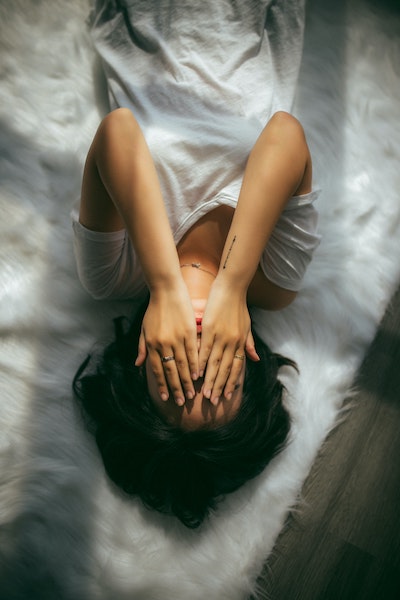Some common reasons why we experience stress in life include things like work, relationships, and daily responsibilities, like going to school or caring for a child. While a little bit of stress can be beneficial, too much stress can have negative effects on both our physical and mental well-being.
When we experience chronic or long-term stress, it can lead to high blood pressure, weight gain, anxiety, and depression. This can be incredibly taxing on our nervous system, making it sometimes hard to return to a state of balance.
And that state of balance we all strive for is called homeostasis . The neuroscience behind this concept is complex, but in short, homeostasis is our body's ability to maintain stability despite changes in the environment.
And to get to this state, you've got to know how to use methods for nervous system regulation, and I'm going to show you exactly how with a few simple techniques.
But first, let's take a closer look at the systems running behind the scenes that control our stress levels.
The nervous system is made up of the central nervous system, which includes the brain and the spinal cord, and the peripheral nervous system, which consists of all the nerves that branch out from the brain and spinal cord to the rest of the body.
The autonomic nervous system controls all the automatic processes in our body, like our heart rate, blood pressure, and digestion. This system is further broken down into the:
The Sympathetic Nervous System – This is responsible for the "fight or flight" response or the reason we might feel alerted or aroused.
Parasympathetic Nervous System – This helps us rest, relax, and digest, essentially controlling the body's unconscious actions.
The two divisions of the autonomic nervous system often work in opposition to each other. For example, when you are scared, your heart rate increases, and you breathe faster because of the sympathetic nervous system. Once the danger has passed, the parasympathetic nervous system returns your heart rate and breathing to normal.
Ideally, we want a balance of both systems working together harmoniously, but often, stress can cause us to tip the scales too much in one direction.

Homeostasis is essential for keeping the body functioning optimally, so it's important to find ways to help regulate the nervous system when needed.
And here are a few ways to regulate your nervous system to achieve this natural balance:
Deep Breathing
When you're feeling stressed, one of the first things you can do is take some deep breaths. This helps to immediately calm the nervous system by sending a message to the brain that everything is okay.
Exercise, for example, is a great way to get those calming signals to the brain and reduce stress and tension in the body. It helps to release endorphins, which are feel-good hormones that have a natural calming effect.
Spending time in nature or grounding is another great way to practice your deep breathing and get some exercise while you're at it. Walking barefoot on the grass or in the sand helps to ground your body and connect you with the earth's energy, which can be incredibly calming.
90-Second Rule
The 90-second rule is a simple way to quickly reduce stress and anxiety, especially when you experience a sudden burst of sympathetic activity, like feeling agitated or panicked.
Studies show that there is a 90-second chemical process that happens in the body when we react to something in our environment. And then, beyond that 90 seconds, the emotional responses that come afterward are just us choosing to stay in that emotional loop.
To break out of that loop, you need to do something else for at least 90 seconds to focus on, which will then reset the chemical process in the body, bringing you back to center.
You can do this by focusing on your breath, counting backward from 100, or even just walking around the block. The key is to find something that you can do for at least 90 seconds that will help to distract you from the stressful situation and reset your nervous system.
Cold Water Plunge
Another way to reduce stress is by taking a cold water plunge. This can be done by either taking a cold shower or bath or even just immersing your hands and feet in cold water for a few minutes.
More modernly known as an ice facial , this method of submerging your face into ice water has been around for many years as a way to improve circulation and reduce stress.
No matter which technique you prefer, the reason this works is that when you expose your body to cold water, it causes an involuntary reflex called the mammalian dive reflex . This reflex slows down the heart rate and constricts the blood vessels, which helps to reduce stress and calm the nervous system. It also helps to release endorphins, which have a natural calming effect.
Visualization
Visualization is another great technique for managing your emotions and regulating your nervous system. This involves using your imagination to picture yourself in a calm and relaxing place.
For example, if you've just experienced a triggering event, close your eyes and picture yourself in a peaceful meadow with the sun shining down on you. You might imagine yourself lying on a beach surrounded by blue sky and white sand. Or you might picture yourself walking through a meadow of wildflowers.
Or, if you're feeling anxious about an upcoming event, imagine yourself confidently handling it and coming out triumphant on the other side!
The goal is to use your mind's eye to create a calming scene that you can come back to when you're feeling stressed or anxious. This can help to quickly reduce your stress levels and calm your nervous system.
So! As you may now realize, we are probably experiencing stress in our lives way more than we think! From the ups and downs of a busy life to navigating work and relationships, to the worry and anxiety of the uncertain times we find ourselves in – it all takes a toll on our nervous system.
But by using some of these simple techniques, we can help to reduce stress, regulate our emotions, and bring our bodies back into homeostasis.
And one more technique I'd like to mention has to do with the regulation of your chakras, or the energy centers in your body, each of which is associated with different emotions and physical areas of the body. When one (or more) of our chakras become imbalanced, it can lead to physical or emotional symptoms.
But I just so happen to have a powerful (and eye-opening!) quiz you can take to determine which of your chakras are out of balance. In fact, this 45-second quiz reveals it ALL, allowing you to then know what actionable steps you can take to heal your chakras and bring your whole system back into balance. Go here now to take the quiz, and I can't wait to see what it uncovers for you .








